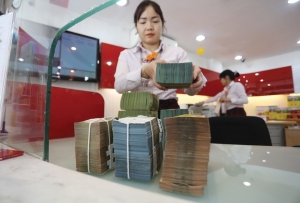Credit growth confronts new pressure
On December 30, the State Bank of Vietnam (SBV) outlined a transparent framework for credit growth in 2025 to 28 commercial banks.
 |
| Maintaining credit growth limits will be necessary to safeguard the banking system, Photo: Le Toan |
The SBV projected an overall credit growth target of approximately 16 per cent for the banking system in 2025. Allocation quotas for individual institutions will be determined based on 2023 ratings, multiplied by a uniform coefficient applied across banks.
In addition to the target, the SBV stated its efforts to phase out and eventually eliminate the direct management of credit quotas for individual institutions.
Previously, the National Assembly urged the government to consider limiting and ultimately eliminating the practice of managing and allocating targets for individual credit institutions.
SBV Governor Nguyen Thi Hong stated that the SBV was reviewing measures to completely phase out this practice.
“During implementation, the SBV has encountered certain challenges and obstacles. Inflationary pressures remain a significant concern, posing challenges to its monetary and credit policy management, which must simultaneously support economic recovery and ensure inflation control,” said Hong.
“Therefore, maintaining the credit growth limit tool is necessary to safeguard the stability of the banking system, thereby contributing positively to inflation control, economic growth support, and macroeconomic stability.”
Economist Dr. Le Xuan Nghia projected that 2025 is unlikely to witness a breakthrough in business confidence, particularly in the domestic private sector, spanning industrial production, manufacturing, and real estate markets. However, the agro-forestry-fishery sector may sustain positive growth momentum.
“The industrial production and manufacturing sectors remain tied to export orders, and forecasts suggest a sluggish growth rate in export orders, at least through the first half of 2025,” Nghia said. “The real estate market continues to face challenges in recovery, and restoring supply chains for new projects and clean land resources will take time.”
Consequently, while residential market transactions showed mild recovery in 2024, they are likely to progress slowly in 2025, Nghia added. “Sluggish credit flow into this sector will drag down related industries such as construction, building materials, interior furnishings, and home appliances. As a result, credit growth in 2025 may remain modest, with commercial banks possibly exercising greater caution in expanding it as envisioned by the SBV,” Nghia said.
In the context of a sharp decline in banks urging businesses to borrow additional funds for immediate disbursement, technical credit growth had nearly vanished by the end of 2024. According to Nghia, this stems from weakened business confidence.
“Domestic consumption is declining. The growth rate of total sales, adjusted for inflation, stands at only 5.7–6 per cent, compared to nearly 8 per cent the previous year. This indicates reduced household income and consumer credit, including housing loans,” he said.
Vietnam’s Manufacturing Purchasing Managers’ Index for December, published by S&P Global on January 2, was at 49.8 per cent, below the 50-point threshold. This is the lowest in three months, with employment indicators declining continuously, particularly in Q4.
According to Tran Thi Khanh Hien, director of MBS’ Research Division, economic developments indicate that credit activities in 2025 could be bolstered by two factors: robust economic recovery and high public investment spending.
“Economic recovery in 2025 will be driven by the resurgence of production and trade activities, fuelled by increased domestic and international demand. This recovery is supported by the SBV’s continuation of accommodating monetary policies,” Hien said.
“Accelerated public investment in 2025 is expected to create jobs and stimulate credit demand, aligning with the goals of economic recovery and completion of major infrastructure projects under the 2021-2025 plan,” Hien added.
She also noted that banks that exhausted their high credit limits in 2024 would enjoy a competitive advantage in securing equivalent limits for the 2025 fiscal year.
“In addition, growth in provisioning expenses and improved asset quality in 2024 will alleviate pressures from non-performing loans in 2025, as retail credit growth rebounds,” Hien explained. “The strong recovery of net interest margins in 2024 will provide banks with room to lower lending rates, creating a critical advantage in expansion in 2025.”
 | Banks confident of achieving profit targets With credit growth gaining momentum in the last two quarters of the year after a slow start in the first half, banks are optimistic about meeting their annual profit targets. |
 | Banks deliver bright profit picture Banks have continued to post promising profits for 2024, buoyed by strong credit growth in the latter half of the year. |
 | Banks expedite massive bond issuances to raise capital before new year Banks are issuing bonds to raise capital at high interest rates, driven by a clear improvement in year-end credit growth and positive forecasts for 2025. |
What the stars mean:
★ Poor ★ ★ Promising ★★★ Good ★★★★ Very good ★★★★★ Exceptional
Related Contents
Latest News
More News
- As global green supply chain reshapes, will Vietnam be left behind? (December 19, 2025 | 08:00)
- Banks gear up for massive capital increases (December 18, 2025 | 17:04)
- Securing capital and efficiency for Vietnam’s 2026-2030 growth ambitions (December 17, 2025 | 10:00)
- Energy sector in need of blended finance mechanisms (December 17, 2025 | 09:00)
- Vietnam still has room to mobilise capital for sustainable growth (December 17, 2025 | 08:57)
- Long-term capital seen as key hurdle to green growth (December 16, 2025 | 08:00)
- Gold prices swing amid tax debate and import uncertainty (December 15, 2025 | 18:04)
- Agribank frames bank credit as catalyst for green growth (December 15, 2025 | 17:59)
- Vietnam’s green transition demands collective financial action (December 15, 2025 | 12:00)
- VIR workshop highlights capital and policy for sustainable development (December 15, 2025 | 11:00)

 Tag:
Tag:





















 Mobile Version
Mobile Version